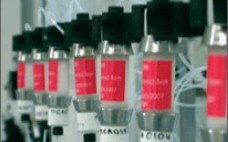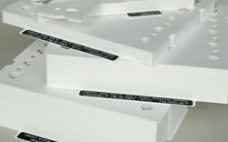Over the past 10 years, disposable bioreactors have grown from a niche tool servicing small-scale projects to a common and essential component in the CGMP production of human therapeutics (1). Recent advances in filter integration, aseptic connectors, and disposable sensing allow entire cell culture processes to be performed using only single-use components. However, harvest and clarification operations remain largely dependent on centrifugation, cross-flow filtration, and depth filtration (2), which are all techniques that have not been widely adapted to single-use…
Downstream Processing
Hydrophobic-Interaction Membrane Chromatography for Large-Scale Purification of Biopharmaceuticals
Biopharmaceutical manufacturing is divided into two areas: upstream fermentation or cell culture and downstream purification processes. Each area contains multiple unit operations. A unit operation is defined as a step in processing using a particular type of equipment. Here, we focus on downstream process development, which must reliably produce a highly purified drug substance (often >99%). Downstream processing includes recovery, capturing, and polishing steps. The primary downstream unit operation is chromatography because of its simplicity and high resolving…
A Presanitized, Purpose-Designed, Single-Use TFF Strategy
For many years, biopharmaceutical manufacturers have worked to increase capacity, address upstream production issues, and improve product yields. Notable successes recently achieved in upstream technology have significantly increased expression rates and therefore, upstream production capacities. Successes in generating higher titers combined with increasingly stringent quality and regulatory requirements have led to a number of challenges in aligning the efficiency of downstream processing with upstream titers. It is generally recognized that downstream processing costs account for about 70% of…
Single-Use, Continuous-Countercurrent, Multicolumn Chromatography
Over the past decade, improvements in the biopharmaceutical manufacturing industry have resulted in a dramatic rise in the expression levels from animal cell cultures – some mAb titers have increased 30-fold over the last 15 years. However, increased titers have led to an increase in downstream bottlenecks. To address this challenge, some manufacturers are turning to multicolumn chromatography.
The principles of simulated moving-bed technology can be applied to create a continuous-countercurrent process. The first column in a loading train is allowed to break through, and material coming off it is captured on a second column. Binding capacity can thus be exploited beyond dynamic binding capacity. These processes often significantly improve media use – and hence significantly reduce consumption of media and buffers.
A Presanitized, Purpose-Designed, Single-Use TFF Strategy
As downstream processing accounts for about 70% of the total biomanufacturing cost, it is easy to see why improvements in product recovery and purification are urgently needed. One possible response to this need is the implementation of a single-use TFF process strategy.
Sius “single-use” cassettes provide a unique solution for a cost-effective downstream processing, with measurable cost-in-use savings, while eliminating a significant amount of time performing burdensome clean-in-place (CIP) procedures. This case study outlines the experimental design, development studies, and proposed single-use commercial TFF process based on work performed by Mike LaBreck at Groupe NovaSep.
Case Study: Evaluation and Implementation of a Single-Stage Multimedia Harvest Depth Filter for a Large-Scale Antibody Process
While in the process of transferring to a new manufacturing facility, scientists and engineers at Genentech, Inc. performed small-scale studies to evaluate several candidates for a single-stage depth filter train to accommodate existing equipment at the new facility.
After testing several dual-layer, single-stage filter media, the team chose a robust filter and implemented it at commercial scale. By replacing the traditional two-stage filtration train, they were able to provide significant cost savings relative to piping reconfiguration, new equipment purchase, and new equipment validation. To learn more about the testing methods and results of this study, download the PDF linked below.
Development of a High-Capacity MAb Capture Step Based on Cation-Exchange Chromatography
Protein A affinity chromatography is traditionally used as the capture step for monoclonal antibodies (MAbs) (1,2,3). It yields high purity because only the fragment-crystallizable (Fc) region of an antibody (IgG1 or IgG2) or Fc-containing fusion protein can bind to the protein A ligand. The resulting specificity provides substantial reduction in impurities such as host cell proteins (HCPs) and DNA (4,5,6,7,8). The dynamic binding capacity of protein A chromatography resins is generally ≤40 g/L and depends highly on residence time because…
Implementation of Single-Use Technology in Biopharmaceutical Manufacturing
Single-use filtration systems are increasingly replacing traditional stainless steel filter assemblies, piping, and tanks for purification and storage of bioprocess fluids in biopharmaceutical manufacturing. Unfamiliarity with polymeric materials and the need to ensure patient safety, however, have made extractables and leachables from these new components and systems a primary concern of process developers along with specialists in quality, validation, regulatory affairs, as well as agency reviewers. A general risk-based approach to determination of extractables and leachables from disposable bioprocess equipment…
Increasing MAb Capture Productivity
Continually increasing bioreactor titers is placing pressure on downstream processing, especially chromatography steps, to process the greater mass of protein produced. Whereas an order of magnitude increase has been seen in titers over the last few years, no similar increase has yet been achieved in the capacity of chromatography resins. Meanwhile, the industry is coming under rising pressure to reduce manufacturing costs and the resulting cost per gram of monoclonal antibodies (MAbs) produced. Because of the specificity it offers, protein…
Development of a High-Capacity MAb Capture Step Based on Cation-Exchange Chromatography
With new advances in expression vectors, the bioprocessing industry has seen a significant increase in antibody expression levels. To meet the demands of these increased titers, protein A chromatography columns need to be further scaled up in size and/or run in multiple cycles — with a consequent increase in buffer consumption, preparation, and storage. One way to address this problem is to develop other capture steps with high-capacity resins that can replace the protein A step.
This article outlines the methods and materials used to develop a high-capacity capture step using cation-exchange (CEX) chromatography to replace the existing protein A chromatography – making it possible to use existing chromatography hardware and eliminate increases in the buffer volume and holding tank size at existing manufacturing plants. Download the full article as a PDF below.




